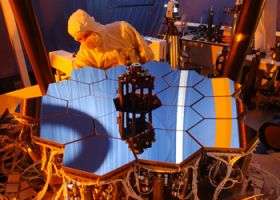Software coordinates 19 mirrors, focuses James Webb Space Telescope

Scientists and engineers have created and successfully tested a set of algorithms and software programs which are designed to enable the 19 individual mirrors comprising NASA's powerful James Webb Space Telescope to function as one very sensitive telescope.
NASA researchers will present findings on these algorithms and software programs, called the "Wavefront Sensing and Controls" at the Optics and Photonics meeting of the Society for Photo-Optical Instrumentation Engineers (SPIE) meeting.
The WFSC system is put to work when the telescope takes digital pictures of a star. It then processes the images through mathematical algorithms to calculate the mirror adjustments required to bring the stellar image into focus. When the individual mirrors are properly aligned, the Webb Telescope will be able to obtain extraordinarily sharp images and detect the faint glimmer of a distant galaxy.
Recently, a team of engineers from Ball Aerospace & Technologies Corp., Boulder, Colo. and NASA successfully tested the WFSC algorithms, proving they are ready to work on the Webb Telescope in space. The algorithms were tested on a detailed scale model of the 6.5 meter space telescope and through computer simulations.
"This major technological accomplishment, which built on the legacy of software algorithms used to fix the Hubble Space Telescope and align the Keck telescope, is a major step forward in the development of JWST. This achievement was the result of great teamwork between Ball Aerospace, NASA Goddard Space Flight Center, and the Jet Propulsion Laboratory," said John Mather, Senior Project Scientist on the Webb telescope at Goddard and the 2006 winner of the Nobel Prize in Physics.
"The same technological ingenuity Ball Aerospace applied to correcting the Hubble Space Telescope’s primary mirror in 1993 is being applied to advancing the optics for the JWST observatory," said David L. Taylor, president and chief executive officer of Ball Aerospace & Technologies Corp.
Source: Goddard Space Flight Center





















